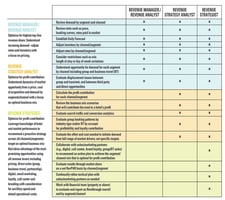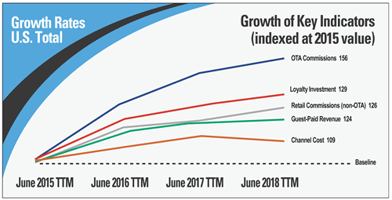By Cindy Estis Green
Published Articles
3 Changes for Moving Forward
By: Cindy Estis Green & Vince Cusma
NOTE: Originally published in Hospitality Upgrade Fall 2020 Edition
Few can afford to return to the staffing levels or the organizational structures of 2019. If there isn’t funding to do it the 2019 way, it can seem daunting to accomplish revenue and profit goals with the budget reductions required by the COVID-19 downturn. The reset button got pushed and now is a good time to carefully assess every aspect of how revenue is generated and at what cost.
No one can reasonably expect to do what was done before with fewer sales and marketing staff and related spending such as digital media, promotion and commissions. However, that doesn’t make it an impossible task – it calls for leaving the old structure behind and building for the new world order. A different approach means applying a laser focus on the essential tasks. The reality was that in 2019, hotels were paying 15-25% to acquire their revenue; this includes (among other costs): commissions, channel/transaction fees, loyalty costs, sales payroll and digital media. In a limited demand market, rate growth will likely continue to be muted as it was already in 2019, and costs to convert demand are likely to rise, not decline. More hotels chasing less demand can lead to third parties raising commission rates. As the industry witnessed in past downturns, OTA commissions often exceeded 30-35% for many properties including commission overrides and third party “partner” marketing programs.
3 Changes Moving Forward
There are three primary Changes that can be made to enable effective performance while still accounting for the funding/staffing constraints.
-
ORG STRUCTURE: view the team as one unit addressing all aspects of commercial strategy. Legacy sales, revenue management and eCommerce teams can inadvertently under- or overspend because they could each reasonably claim they were effective when only considering revenue and cost of their own channels in isolation. Decisions like maintaining head counts in sales were rarely considered in light of needs to increase spending in digital media or promotions. A head of commercial strategy is able to integrate revenue generation and spending decisions in one team. Automated revenue management system guidance that is often second-guessed may have to be trusted more so limited staff has bandwidth to apply analytical skills to tradeoff decisions for sales staff deployment, group pricing and spending decisions around media or brand promotions. With 60-70% of customer acquisition funds spent on sales and marketing initiatives, this shift could yield higher returns for a hotel or group of hotels and leverage a critical skill set that has been typically siloed around pricing issues.
-
BUDGET: Even when following USALI guidelines, be transparent about the spending limits with the entire team as though there is one pool of funds, one budget – not always shown as separated into sales, digital, third party commission or revenue management budgets. Take the top line revenue minus costs of acquisition and be sure everyone knows that single net revenue number. That is a hotel’s revenue “flow through” or the cash that contributes to debt, fixed expenses and ultimately a hotel’s profit. It’s all that really matters in today’s cash-constrained hotel operation. Everyone has to recognize that commissions are a manageable expense, not a “cost of doing business” and if you overspend with third parties, you may not have the needed funs for brand or internal promotions that can yield higher profit margins. Operational costs will be largely the same for all room nights, but acquisition costs can vary widely. When a decision has to be made about adding sales payroll or spending on digital media or participating in a brand promotion, it has to be evaluated in the context of the overall net revenue target. This can’t be done in a silo. The commercial team has to examine every opportunity and see how it impacts the hotel’s net revenue objective.
-
PERFORMANCE ASSESSMENT: Goals and objectives have to account for both revenue and cost for all teams. Gone are the days when hitting a top line RevPAR number or sales target is enough. Everyone has to take responsibility for achieving revenue at agreed acquisition costs. Management has to know the net revenue number, monitor results based on that number, and reward for success in achieving that number.
Be Strategic
How should you allocate cash between sales, digital and promotions?
When cash is limited it needs to be closely managed. The 15-25% of guest paid revenue that is spent for revenue generation can be best deployed when budgets and teams are working against one pool of funds. Skills will certainly be differentiated; this isn’t about having salespeople become revenue management experts or revenue managers running eCommerce, but it comes down to decisions about resource allocation and tradeoffs between sales, digital, and promotional decisions. These decisions can be driven by data and technology, so the limited staff is freed up to do what they do best – execute against the plan.
-
How many sales staff should be deployed for each type of business and/or geography?
-
Should they focus on specific timeframes e.g. months, weeks or weekend vs. weekday?
-
If above property, how many sales resources for each hotel for each type of business?
-
Is the team agile and nimble enough to shift deployment quickly when needed based on the best opportunities available?
-
How much to spend overall in digital? Will this require a reduction in sales staffing or brand promotional spending?
-
If tapping digital channels, which rate categories during what time periods?
-
Is this the highest and best use of funds to get the targeted business?
-
Which digital channels yield the best returns for the targeted rate categories? If a brand is involved, how can a hotel or market effort get additional leverage by joining with the brand?
-
How should funds be allocated between OTA promotions vs. loyalty member promotions?
-
How is the OTA channel being monitored to be sure it’s not cannibalizing direct?
-
Rack/BAR or loyalty member rate business? Who is doing this and how often?
-
Which brand promotions are worth pursuing? Will this spending still allow for the needed local sales and digital spending? If needed, are there tradeoffs that can be made by staggering deployment of digital and promotional spending, so they aren’t during the same weeks/months?
Take Away
One team, one budget and improved commercial analysis can yield positive results even when spending and staffing is significantly reduced. The use of data and technology will be more important than ever to drive smarter decisions. No one can do what they did before the downturn with less resources, but they can still succeed and thrive in a recovery. It calls for cross-discipline decisions made by an integrated commercial organization, and limited resources being deployed with careful thought, continual monitoring and a focus on profit contribution.




